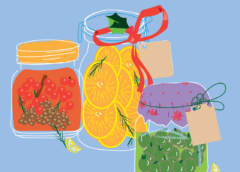Jarred and bottled are the two most prevalent pack types. Everybody is familiar with their wide use, even though some are unaware of its advantages and disadvantages. Both jarred, and bottle-based packaged goods are popular in the foodservice industry. Like bottles and cans, this is also a more convenient way to store products or food. This makes it simpler to keep things or food fresh compared to other packed forms.
Types of Jarred Packed Goods and its Benefits
Using jarred packed foods has several advantages and no significant cons. This method of packaging saves time and money for a business owner. It also provides them with a sense of autonomy and a customized touch that they like. Let’s look at some of the advantages and kinds of this style of packing in terms of time and money savings:
Plastic Bottles Packaging:
The most prevalent item discovered in the trash in distant locations is plastic bottles and jarred packaged foods, which can take up to 1,000 years to degrade. Plastic bottles and jars have an ineffective recycling process, which means that when they are recycled, the quality is typically low, and only about a fifth of them can be recycled. Furthermore, when plastic bottles are disposed of in landfills, harmful substances are frequently released into the soil and groundwater.
Plastic bottles contribute significantly to pollution. Water and other beverages are served in them. Because they’re made of petroleum, which isn’t renewable, they can’t be recycled. This section will discuss plastic bottles and some of the issues they can cause.
Packaging made of cardboard:
Compared to aluminum, metal, and plastic, cardboard bottled and jarred packaged items are more eco-friendly and cost-effective. Because of its low cost and ease of storage, shipping, and recycling, cardboard packaging saves the firm more than metal and plastic packaging. It is inexpensive, lightweight, and recyclable.
To market their products, several businesses employ cardboard packaging. Keep a few things in mind while developing cardboard packaging for your goods. These factors might include the material’s long-term viability, cost-effectiveness, and whether the design has any restrictions in terms of manufacturing.
Packaging in glass containers
Jars made of glass are an excellent renewable material that can also be recycled. They have a square glass form with a variety of sizes, shapes, and thicknesses to choose from.
Glass containers in the food sector have the advantage of not allowing germs to grow or releasing hazardous compounds when microwaved or frozen. They keep food in a sterile, contained environment, which is ideal for preventing infection and deterioration.
Glass containers are the greatest option for keeping liquids since they are usually sealed. They are frequently fashioned of tempered glass, which is both easy to clean and long-lasting. Tempered glass is used to make bottled and jarred packaged foods, which is easy to clean and long-lasting.
Metal Packaging:
The airtight seal of the container, made possible by the metal, assists in food preservation over time. Because of the benefits of metal containers in terms of product safety, canned food is usually packaged in them. Cans are commonly used to keep a variety of goods, such as fish, fruits and vegetables, as well as pates. Metal containers are difficult to keep clean.
Packaging made of wood
Wooden packaging might be a viable option for both product and environmental aspects. The advantages of adopting this material are numerous, ranging from sustainability to aesthetics. Natural tree components are used to make wooden packing materials.
They may be utilized to make a long-lasting material with various textures and appearances.
Wooden packing items can provide several benefits: Recyclable, renewable, reusable, and more cost-effective than many other products because of their visual and tactile features.
However, there are certain disadvantages:
- Wooden packaging is not as sturdy as plastic or metal.
- It cannot be utilised for the same duties.
- Customisation possibilities are limited.
Packaging for Aluminium Containers
Aluminum makes bottled and jarred packaged goods significantly lighter and more stable than glass and plastic. These containers have the advantage of being reusable and recyclable instead of other materials.
Aluminum cans can also be delivered without additional packing since they are lightweight and sturdy. This saves money. When it comes to packaging food or liquids, aluminum containers provide four distinct advantages over other materials. Aluminum can be formed into various forms and sizes, and it is commonly used to hold liquids and gases. Food can be stored in aluminum containers.
Pros of Bottled and Jarred Packaged Goods
Bottled and Jarred Packaged Goods have the following advantages:
- Hygienic:
When it comes to commodities, one of the most important aspects is the container’s cleanliness. A glass container does not require oxidase, does not emit harmful radiation, and does not affect the contents.
- In a Smaller Package, a Better Product:
Containers and bottles are usually displayed on enormous display racks. In other situations, though, customers may be unable to find a little container large enough to hold the things they are purchasing. You must guarantee that your shelf-lifter is of the finest quality to get the most out of it.
- Ecologically friendly:
A good glass container is a great choice because it is safe and ecologically friendly. It has no negative effects on the environment.
- Convenient and practical:
The simplicity with which proper glass packaging may be used is also critical. It’s easy to slip it into your backpack or pocket. You may distribute it or carry it with you on a trip or wherever you go.
Cons of Bottled and Jarred Packaged Goods
As a result, packaged and preserved foods will certainly have their own set of disadvantages. Cons of Bottled Packaged Goods:
- Packaging that is vulnerable to damage:
The fragility of this package detracts from its other favorable characteristics, such as efficiency and intrigue.
- Expensive:
Glass is costly and difficult to get by due to its fragility. As a result, goods sold in jars or bottles are more expensive. You may have noticed that keeping food in tins is less expensive than glass bottles.
Conclusion:
Food that has been cooked, canned, or otherwise stored by being sealed in a sealed jar is referred to as “Bottled and Jarred Packaged Goods.” Some bacteria grow in moist environments with the right temperature, causing food to spoil. Because of rising concerns about the safety of their food supply, more individuals are turning to organic, natural, and locally sourced food.

